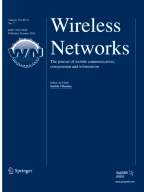Abstract
Due to the flexibility of wireless mesh networks (WMNs) to form the backhaul subnetworks, future generation networks may have to integrate various kinds of WMNs under possibly various administrative domains. Aiming at establishing secure access and communications among the communication entities in a multi-domain WMN environment, in this paper, we intend to address the cross-domain authentication and key agreement problem. We present a light-weight cross-domain authentication and key agreement protocol, namely CAKA, under certificateless-based public key cryptosystem. CAKA has a few attractive features. First, mutual authentication and key agreement between any pair of users from different WMN domains can be easily achieved with two-round interactions. Second, no central domain authentication server is required and fast authentication for various roaming scenarios is supported by using a repeated cross-domain algorithm. Third, no revocation and renewal of certificates and key escrow are needed. Finally, it provides relatively more security features without increasing too much overhead of computation and storage. Our analysis shows that the proposed CAKA protocol is highly efficient in terms of communication overhead and resilient to various kinds of attacks.
Similar content being viewed by others
References
Zhu, X., Fang, Y., & Wang, Y. (2010). How to secure multi-domain wireless mesh networks. Wireless Networks, 16(5), 1215–1222.
Ren, K., & Lou, W. (2008). A sophisticated privacy-enhanced yet accountable security framework for metropolitan wireless mesh networks. In The 28th international conference on distributed computing systems, 2008. ICDCS’08 (pp. 286–294). New York: IEEE.
Zhang, Y., & Fang, Y. (2006). ARSA: An attack-resilient security architecture for multihop wireless mesh networks. IEEE Journal on Selected Areas in Communications, 24(10), 1916–1928.
Li, C., & Nguyen, U. T. (2010). Fast authentication for mobile clients in wireless mesh networks. In 2010 23rd Canadian conference on electrical and computer engineering (CCECE) (pp. 1–8). New York: IEEE.
Gao, T., Guo, N., & Yim, K. (2012). Delegation-based mutual authentication scheme for multi-operator wireless mesh network. In 2012 sixth international conference on innovative mobile and internet services in ubiquitous computing (IMIS) (pp. 143–147). New York: IEEE.
Wong, F.L., & Lim, H.W. (2007). Identity-based and inter-domain password authenticated key exchange for lightweight clients. In 21st International conference on advanced information networking and applications workshops, AINAW’07 (vol. 1, pp. 544–550). New York: IEEE.
Chen, L., Lim, H. W., & Yang, G. (2013). Cross-domain password-based authenticated key exchange revisited. In 2013 Proceedings IEEE INFOCOM (pp. 1052–1060). IEEE.
He, B., Agrawal, D. P. (2010). An identity-based authentication and key establishment scheme for multi-operator maintained wireless mesh networks. In 2010 IEEE 7th international conference on mobile adhoc and sensor systems (MASS) (pp. 71–78). New York: IEEE.
Ren, K., Yu, S., Lou, W., & Zhang, Y. (2010). Peace: A novel privacy-enhanced yet accountable security framework for metropolitan wireless mesh networks. IEEE Transactions on Parallel and Distributed Systems, 21(2), 203–215.
Shim, K. (2003). Efficient ID-based authenticated key agreement protocol based on weil pairing. Electronics Letters, 39(8), 653–654.
Wang, S., Cao, Z., Choo, K.-K. R., & Wang, L. (2009). An improved identity-based key agreement protocol and its security proof. Information Sciences, 179(3), 307–318.
Wang, S., Cao, Z., Cheng, Z., & Choo, K.-K. R. (2009). Perfect forward secure identity-based authenticated key agreement protocol in the escrow mode. Science in China Series F: Information Sciences, 52(8), 1358–1370.
I. C. S. L. M. S. Committee et al. (2009). Ieee p802.11s/d2.06: Part 11: Wireless lan medium access control (MAC) and physical layer (PHY) specifications. Amendment 10: Mesh networking.
Zhang, L., Zhang, F., Wu, Q., & Domingo-Ferrer, J. (2010). Simulatable certificateless two-party authenticated key agreement protocol. Information Sciences, 180(6), 1020–1030.
Mokhtarnameh, R., Ho, S. B., & Muthuvelu, N. (2011). An enhanced certificateless authenticated key agreement protocol. In 13th International conference on advanced communication technology (ICACT) (pp. 802–806). New York: IEEE.
Shi, Y., & Li, J. (2007). Two-party authenticated key agreement in certificateless public key cryptography. Wuhan University Journal of Natural Sciences, 12(1), 71–74.
Al-Riyami, S.S., & Paterson, K.G. (2003). Certificateless public key cryptography. In Advances in cryptology-ASIACRYPT 2003 (pp. 452–473). Berlin: Springer.
Cheng, Z., & Comley, R. (2005). Efficient certificateless public key encryption. IACR Cryptology ePrint Archive, 2005, 12.
Boneh, D., & Franklin, M. (2001). Identity-based encryption from the weil pairing. In Advances in Cryptology—CRYPTO 2001 (pp. 213–229). Berlin: Springer.
Guo, H., Li, Z., Mu, Y., & Zhang, X. (2011). Provably secure identity-based authenticated key agreement protocols with malicious private key generators. Information Sciences, 181(3), 628–647.
Zhang, Z., Wong, D. S., Xu, J., & Feng, D. (2006). Certificateless public-key signature: Security model and efficient construction. In Applied cryptography and network security (pp. 293–308). Berlin: Springer.
Zhu, X., Jiang, S., Wang, L., & Li, H. (2013). Efficient privacy-preserving authentication for vehicular ad hoc networks. IEEE Transaction on Vehicular Technology, 63(2), 907–919.
Wander, A. S., Gura, N., Eberle, H., Gupta, V., & Shantz, S. C. (2005). Energy analysis of public-key cryptography for wireless sensor networks. In Third IEEE international conference on pervasive computing and communications, PerCom 2005 (pp. 324–328). New York: IEEE.
Acknowledgments
This work was partly supported by the National Natural Science Foundation of China under Grants 61402275, 61373150, 61379145, 61232016, U1405254, 61202317, 61272436, Shaanxi Province Natural Science Basic Research Program Funded Project 2015JM6263, the PAPD fund, the Fundamental Research Funds for the Central Universities under Grant GK201402004.
Author information
Authors and Affiliations
Corresponding author
Rights and permissions
About this article
Cite this article
Li, Y., Chen, W., Cai, Z. et al. CAKA: a novel certificateless-based cross-domain authenticated key agreement protocol for wireless mesh networks. Wireless Netw 22, 2523–2535 (2016). https://doi.org/10.1007/s11276-015-1109-7
Published:
Issue Date:
DOI: https://doi.org/10.1007/s11276-015-1109-7
